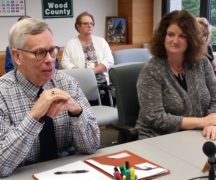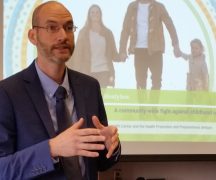By JAN LARSON McLAUGHLIN
BG Independent News
Bowling Green already has the largest solar field in Ohio. Now it’s working on building the largest community solar project in the state.
If all goes as planned, this solar field will sit on 70 acres just west of Wood Lane, just north of East Gypsy Lane Road near Interstate 75. The project requires teamwork, since 50 acres are owned by the Wood County Commissioners, and 20 acres are owned by the Wood County Board of Developmental Disabilities.
This project is intended to be a “community solar project,” which means city residents and businesses could sign up to be a part of the project and get electricity from the kilowatts generated at the solar field, according to Bowling Green Public Utilities Director Brian O’Connell.
“It would allow you the lease of the output for a year,” said Daryl Stockburger, assistant director of the Bowling Green Public Utilities Department.
That would make this project different from the 165-acre solar field recently constructed on city land at Carter and Newton roads. Bowling Green gets a portion of the power generated at that solar field – enough to supply nearly 5 percent of the city’s energy needs.
By building a “community solar” project, all of the energy created at the proposed site could be used to power Bowling Green, O’Connell said.
The East Gypsy Lane site is appealing because it is close to existing city facilities that can be tied into. There would be no need to build several miles of power poles and wires. “We have the infrastructure near there,” O’Connell said.
The “community solar” concept is a growing trend across the nation, according to O’Connell. Bowling Green residents and businesses could sign up to be part of the project – on a purely voluntary basis.
“Instead of putting solar on rooftops, this could be done at a lower cost,” O’Connell said.
Bowling Green officials have been looking for open space for more solar panels.
“Peaking energy is important to us,” O’Connell said Tuesday. “We’re looking for new ways to do more solar. But finding large parcels of property close to the city is difficult.”
Then the city found that big chunk of land right in its backyard – and close to its city electric service.
“This would be an ideal location for this,” Stockburger said.
So on Tuesday, city officials asked the Wood County commissioners to give them a three-year lease option, which will allow the city to discuss the project with solar developers.
“If you don’t have the land, they can’t give you an accurate price for the layout,” O’Connell said.
The Wood County Board of Developmental Disabilities has already signed off on the lease option for its acreage.
“We would be glad to move forward,” Commissioner Doris Herringshaw said about the county’s acreage. The agreement will be reviewed again by the county prosecutor’s office prior to it being signed.
“Exciting change is in the air again,” Herringshaw said.
“It’s a nice partnership,” Wood County Administrator Andrew Kalmar said.
Ideally, the acreage has room for enough solar panels to generate 10 megawatts of energy. The panels would likely rotate with the sun during the day to maximize the energy generated, O’Connell said. Bowling Green’s share of the power from the larger solar field on Carter Road is 13.74 megawatts.
The acreage is currently rented out for agriculture, and will continue to be until the time solar panels are installed.
Any solar deal will likely last about 30 years, O’Connell said. Then the decision would be made to continue with the solar arrays or remove them and revert the acreage back to farmland.
If crops in the fields are damaged during the three-year lease prior to the solar field being built, the subleaser would be responsible for making the farmers whole, Stockburger said.
Commissioner Craig LaHote noted that the proposed solar site would be easily visible by traffic on Interstate 75.
Commissioner Ted Bowlus asked about the new location using locally built panels. “It would be nice if you could use First Solar panels,” he said.
O’Connell and Stockburger agreed, but said it may not be possible because of production contracts that already have First Solar stretched.
The commissioners also discussed that in order to get state support for the new solar field, at least 80 percent of the labor constructing the site much be local.





